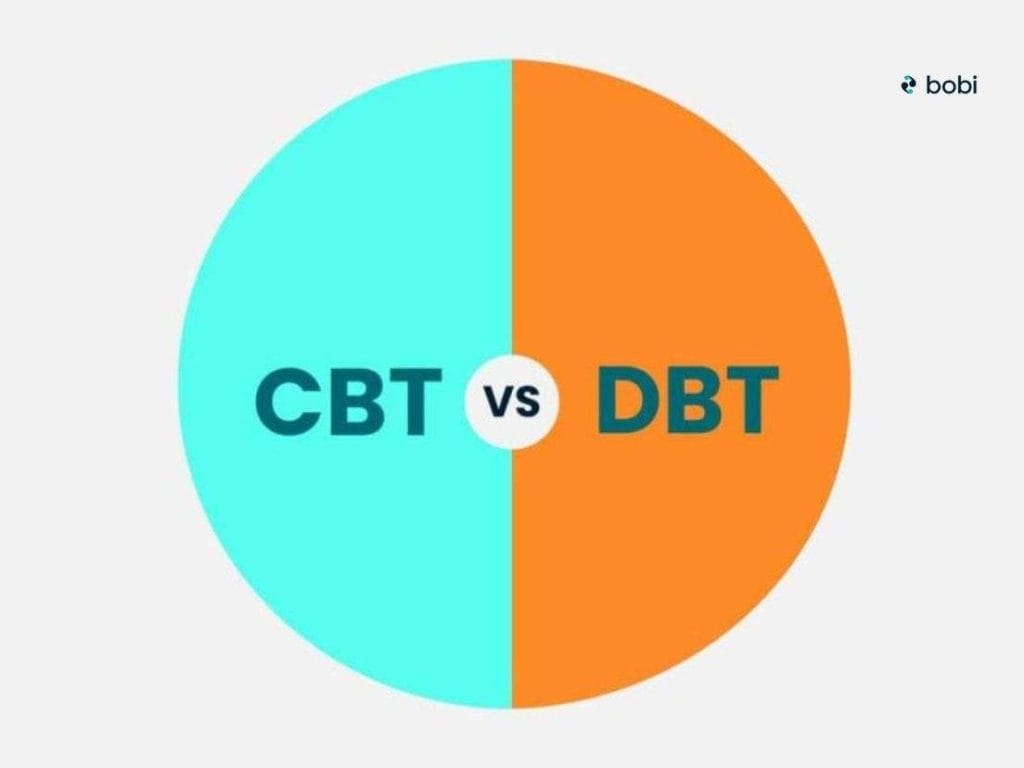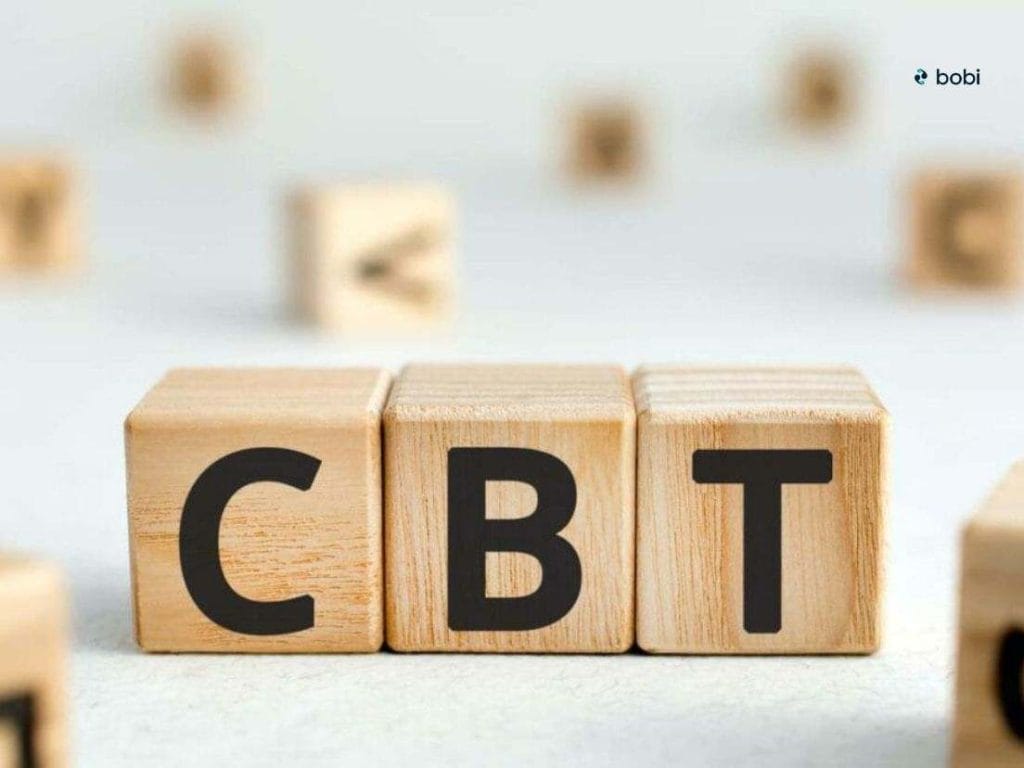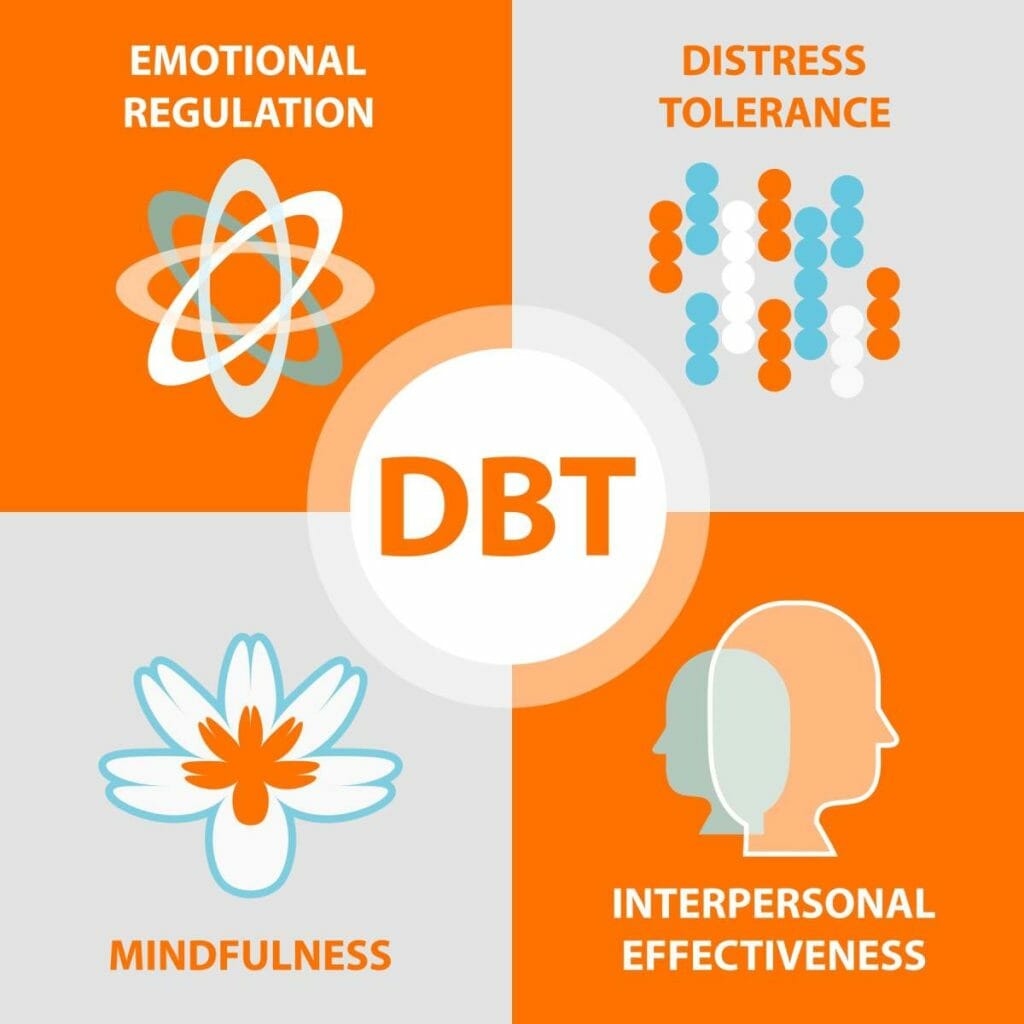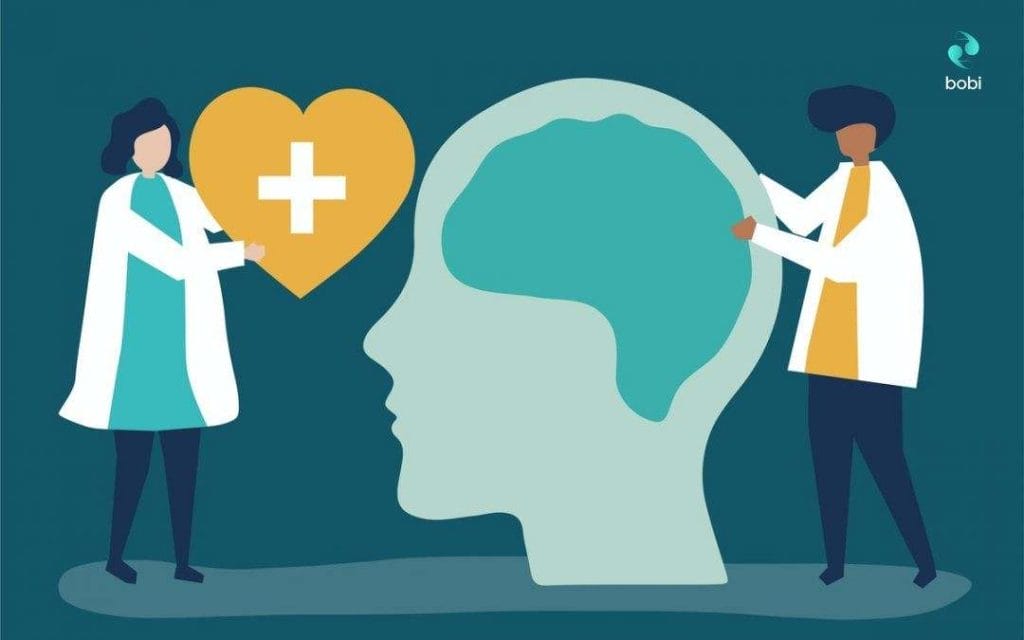
I often get asked by my patients what’s CBT vs DBT? It can be quite confusing trying to understand these different mental health treatment modalities, so I thought I’d cover it in a blog. Given we experience up to 6,000 thoughts each day, this leaves us ample room for negative thoughts. It’s important to understand how the two therapy types can help us manage these potentially negative thoughts and emotions.
Cognitive Behavioral Therapy (CBT) is a widely known therapy that helps people with anxiety, depression, and other mental health problems. Dialectical Behavioral Therapy (DBT) is another type of therapy that’s specifically designed for people with borderline personality disorder, but it can also help with other conditions. In this blog post, we will dive deeper into CBT vs DBT by uncovering their history, key features, how they both work and how they’re delivered. We’ll also compare the key differences between the two techniques and discuss when each one is more suitable. So, by the end of this post, you’ll have a much better understanding of these two therapies, which will help you make an informed decision about your mental health treatment.
The modern roots of CBT can be traced to the development of behavior therapy in the early 20th century. Aaron T. Beck then developed cognitive behavioral therapy (CBT) in the early 1960’s, targeting unhelpful thoughts and behavior patterns. Conversely, Marsha Linehan created dialectical behavior therapy (DBT) in the early 1990s to initially treat individuals with borderline personality disorder, emphasizing distress tolerance and emotion regulation.
Over time, both CBT and DBT have evolved to address mental health issues, personality disorders, and substance use, contributing to effective therapeutic interventions for distress tolerance.
The development of these therapies has significantly impacted the field of talk therapy, offering valuable strategies for individuals seeking the right therapist and specific goals.

The very first question that I encounter often is ‘what is cbt’. Cognitive Behavioral Therapy (CBT) is a form of talk therapy that focuses on changing negative thought patterns and behaviors. It has been proven to be effective in treating various conditions, including anxiety, depression, and PTSD. Typically delivered in the form of group sessions or individual therapy, CBT helps individuals identify specific goals and develop behavioral skills to address their concerns. One of the key behavioural skills learned is the habit of slow conscious breathing.
Key features of CBT involve identifying negative thoughts and behaviors, utilizing a structured framework, and collaborating with the therapist. This type of therapy has a strong evidence base, supported by numerous studies demonstrating its effectiveness in treating various mental health issues.
CBT emphasizes talk therapy and the development of behavioral skills to address mood disorders, chronic pain, and suicidal ideation. The right therapist can help individuals set specific goals and acquire new skills, making this form of CBT beneficial for addressing a wide range of challenges in social situations.
The goal of CBT is to help individuals develop new coping strategies that are more adaptive and effective so that they can live happier, healthier lives. During CBT sessions, individuals work with a therapist to identify negative thought patterns and behaviors that are contributing to their distress. The therapist then helps the individual develop new, more positive ways of thinking and behaving, which can help to reduce symptoms of anxiety, depression, and other mental health conditions. This is how dbt vs cbt for anxiety works.
By practicing these new coping strategies in real-life situations, individuals can learn to manage their emotions more effectively and improve their overall quality of life.
The effectiveness of CBT depends on the individual’s willingness to participate and make lifestyle changes, which can take time and effort but can ultimately lead to lasting benefits.
CBT (Cognitive Behavioral Therapy) can be delivered in various ways, such as individual or group therapy, or through self-help materials. Sessions typically last 50-60 minutes and focus on identifying negative thinking and behavior patterns to replace them with positive ones. Group therapy offers additional support from peers.

Before exploring the differences between these two therapies, let’s first find out ‘what is dbt’. Dialectical Behavior Therapy (DBT) is a type of cognitive-behavioral therapy designed initially for treating borderline personality disorder. It focuses on teaching coping skills to manage intense emotions, improve relationships, and reduce self-destructive behavior through individual therapy, group therapy, phone coaching, and skills training.
DBT emphasizes mindfulness, acceptance, and change and has been proven effective in treating various mental health conditions, including depression, anxiety, and substance abuse.
Research suggests that the therapy promotes emotional regulation and interpersonal effectiveness, making it a valuable form of therapy for individuals struggling with mood disorders and suicidal ideation.
Developed by psychologist Marsha Linehan, DBT combines elements of CBT with mindfulness practices. It focuses on skills training in emotional regulation, distress tolerance, interpersonal effectiveness, and mindfulness. DBT is commonly used to treat borderline personality disorder and other mental health conditions. Its goal is to help individuals create a life worth living by managing difficult emotions and building meaningful relationships. Additionally, DBT can be delivered through individual therapy, group sessions, and phone coaching, providing a diverse approach to talk therapy that addresses the specific goals of each individual.

DBT works by helping individuals regulate their emotions and improve their relationships. Together, the therapist and individual identify strengths, weaknesses, and strategies for coping with difficult situations. DBT includes individual and group therapy, skills training, and phone coaching. Creating a supportive therapeutic environment and building a strong therapeutic relationship is also emphasized.
DBT therapy techniques include individual therapy sessions and group skills training. In individual therapy, clients learn coping skills and address specific issues. Group skills training covers topics like mindfulness, distress tolerance, emotion regulation, and interpersonal effectiveness. Phone coaching may also be provided for crisis support.
In talk therapy, CBT focuses on altering unhelpful thoughts and behaviors, while DBT emphasizes accepting distress and acquiring new skills to manage emotions effectively. Both forms of therapy differ in their targeted mental health issues as CBT primarily addresses specific conditions, whereas DBT is more suitable for individuals dealing with intense emotions and interpersonal challenges. The key differences lie in their treatment philosophies and the specific goals each therapy aims to achieve, ultimately improving the individual’s quality of life through behavioral skills and emotional management.
When it comes to talk therapy, both CBT and DBT have specific goals in mind. While CBT aims to modify irrational thoughts and behavior patterns, DBT focuses on emotional regulation and distress tolerance. CBT is designed to target negative thought patterns and anxiety disorders, whereas DBT is particularly helpful for individuals with borderline personality disorder and suicidal ideation. Ultimately, CBT aims to change unhelpful thinking patterns, while DBT focuses on promoting emotional regulation and healthy behavioral skills. Each type of therapy offers unique benefits tailored to specific goals and individual needs.
While CBT focuses on restructuring thought patterns, DBT integrates change-focused strategies with acceptance-based techniques. CBT emphasizes present-moment thinking patterns, whereas DBT highlights the influence of social factors on emotional regulation. Additionally, CBT prioritizes critical thinking, while DBT places emphasis on mindfulness techniques. Both types of therapy involve talk therapy and group sessions to help individuals develop behavioral skills. By understanding these key differences, individuals can make informed decisions about the type of therapy that aligns with their specific goals and needs.

Both CBT and DBT focus on addressing specific behavior patterns, aiming to modify thought patterns and behavior for improved emotional regulation and interpersonal relationships. They both emphasize the therapeutic process and utilize cognitive behavioral therapy as a form of treatment. Both therapies work towards helping individuals achieve specific goals through various techniques, including talk therapy and group sessions. When seeking the right therapist and type of therapy, it’s essential to consider the similarities and differences between CBT and DBT.
When seeking therapy, it’s essential to understand the common techniques used in CBT and DBT. In CBT, techniques like cognitive restructuring and behavioral activation are employed to address irrational thoughts. On the other hand, DBT focuses on distress tolerance and emotion regulation skills, integrating dialectical behavioral therapy skills training. Both therapies utilize cognitive therapy techniques to address unhelpful thoughts and emotions, emphasizing the development of new skills to manage mood disorders and improve overall well-being. Understanding these techniques is crucial in choosing the right type of therapy and finding the right therapist.
CBT primarily targets transforming negative thoughts and behaviors, whereas DBT emphasizes acceptance and mindfulness, offering a more flexible and individualized approach. DBT also includes specific skills for emotional regulation and interpersonal effectiveness, which are not typically addressed in CBT. While both therapies can be effective for various mental health conditions, they are often utilized for different purposes and populations. It’s crucial to consider the key differences between CBT and DBT when determining the most suitable type of therapy for individuals, ensuring that their specific goals and needs are addressed effectively.
CBT (Cognitive Behavioral Therapy) is a suitable approach for individuals dealing with anxiety disorders, depression, and substance abuse problems.
Numerous studies have shown its effectiveness for mild to moderate depressive episodes. CBT is typically a short-term therapy, consisting of 5-20 sessions that can be conducted individually or in a group setting.
DBT is particularly beneficial for individuals with borderline personality disorder or emotional regulation difficulties.
Research has shown that DBT skills training can reduce anxiety symptoms in psychiatric patients. It focuses on developing coping skills, improving relationships, and reducing self-destructive behaviors. CBT may be better suited for those with anxiety or depression. The choice between DBT and CBT depends on the individual’s specific needs and diagnosis.
In summary, when it comes to understanding CBT vs DBT, both present effective treatment options for managing mental health disorders and enhancing distress tolerance. The choice of therapy depends on individual needs, considering therapy sessions, emotional regulation, and distress tolerance skills. Addressing unhelpful thoughts, emotion regulation, and interpersonal relationships can be achieved through talk therapy. Exploring the form of therapy, type of therapy, and specific cbt and dbt skills training will aid in making an informed decision. Each therapy offers unique benefits, and finding the right therapist to develop new skills for managing intense emotions and behavioral patterns is crucial.
CBT (Cognitive Behavioral Therapy) is a form of talk therapy focusing on changing negative thought patterns and behaviors, primarily used for anxiety, depression, and PTSD. DBT (Dialectical Behavioral Therapy), initially designed for borderline personality disorder, teaches coping skills for managing intense emotions and improving relationships.
CBT works by helping individuals identify and change negative thought patterns and behaviors, contributing to their distress. Its key features include a structured framework, collaboration with the therapist, and focus on developing behavioral skills to address various mental health issues.
DBT aims to regulate emotions and improve interpersonal relationships. It is delivered through individual therapy, group skills training, and sometimes phone coaching, focusing on skills like mindfulness, emotional regulation, and distress tolerance.
CBT is more suitable for individuals dealing with anxiety, depression, and substance abuse. It’s typically a short-term therapy, effective for mild to moderate depressive episodes.
Both CBT and DBT aim to modify thought patterns and behavior for better emotional regulation and interpersonal relationships. They utilize cognitive behavioral techniques and often involve both individual and group therapy sessions
Stay updated on what's happening at bobi, and all things breathing, anxiety and mental wellness.